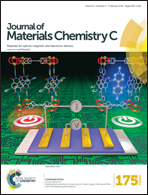Simultaneous enhancement in open circuit voltage and short circuit current of hybrid organic–inorganic photovoltaics by inorganic interfacial modification†
Abstract
One of the key advantages of metal oxide/polymer organic–inorganic hybrid photovoltaic devices is the possibility to control the photo-induced charge separation efficiency by interfacial modification. While a large variety of organic modifiers have been investigated, inorganic modification layers remain largely unexplored. Here, we investigate the model poly(3-hexathiophene)/ZnO system and show that by introducing a caesium carbonate interlayer, a simultaneous increase in all photovoltaic performance parameters can be achieved. While improved energy level alignment results in a significant increase in the open circuit voltage, the suppression of interfacial bound charge pairs formation causes a reduction in interfacial recombination losses and an increase in short circuit current. The overall power conversion efficiency is enhanced twelve fold, demonstrating the significant potential of inorganic modifiers for improving the performance of hybrid photovoltaic devices.

- This article is part of the themed collection: Celebrating our 2018 prize and award winners

 Please wait while we load your content...
Please wait while we load your content...